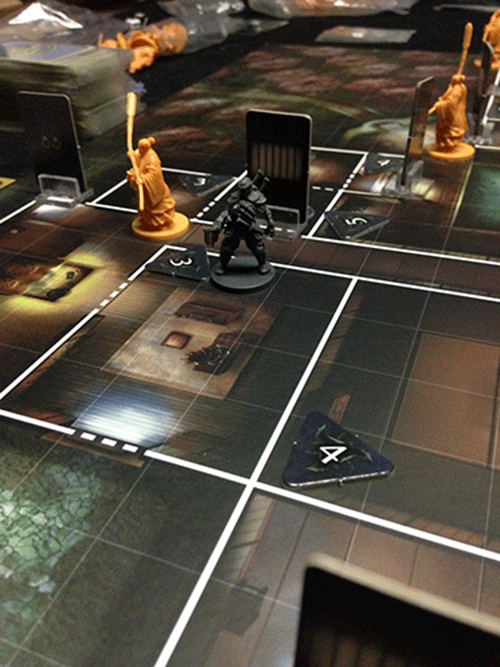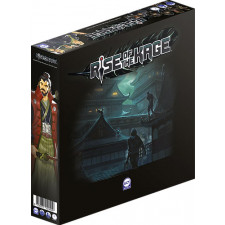Rise of the Kage Review
on Sep 8, 2016
Rise of the Kage is a beautiful game featuring stealthy ninjas, skulking guards, and a bucket full of drama. It also shipped with one of the most ghastly rule-books you'll ever see. Systems are unclear, the procedures are confusing, and balance is about as close as Tokyo is to Philly. Before you even consider pushing these minis around or fondling the cardboard, you need to head to the internet and download the final version of the manual. Unfortunately, grasshopper, you can't toss out the existing version because you still need the setup instructions for the maps.
Diving into a game already bruised is rarely a good sign. Yet, somehow Rise of the Kage climbs above the controversy and delivers a roundhouse to your skull. This unique design combines elements of hidden movement games with that of dungeon crawlers to produce something that sits in a really interesting space. Similarities and influence are obvious but this boasts a slightly different feel than Ninja: Legend of the Scorpion Clan or Descent.
One to three players take on the roles of ninja attempting to infiltrate the enemy lair. Missions are drawn from a deck and consist of uncovering search points seeded on the map, assassinating individuals, and performing reconnaissance. Like everything else in this design, the variety is outstanding and replayability far outstrips its peers.
Another player takes on the role of one of two bosses and attempts to thwart the scoundrel's plans. Unfortunately you do not know what their mission actually is so you have to adapt and keep your defense fluid. Play is completely asymmetrical yet both sides are very rewarding.
The board you’ll wage shadow-war on is double-sided offering two interesting venues for tomfoolery. Both the manor house and merchant district contain a different maze of rooms and approaches and feel different enough to demand thorough exploration. Setup also includes a wide range of options. You select a specific Daimyo, different types of guards, where search tokens go, which rooms have doors (two types), and where bell and lantern tokens go. It sounds overwhelming because it is.
Sorting all of the bits out and properly setting up the map just to start playing is time consuming. There's an element of strategy here which is nice but likely not worth the time. Typically you will either want to hurry it along or setup the game before meeting up with your opponents. It does speed up upon multiple plays but your first few experiences will be a slog. Not including predetermined options is a misstep that will hopefully be corrected down the line.
This philosophy of many options is threaded throughout the design. It results in a somewhat dense set of rules that overshadows a simple core engine. You have multiple tracks, variable action points, noise tokens, hands of cards, different stats for multiple types of guards, asymmetrical ninjas, and an enemy boss with their own rules.
This is the double-edged blade of Rise of the Kage. The mountain of content within is awesome. The plethora of options and abilities means this will stand up to many plays. It also means that if you come back to this on your shelf after a couple of months you will struggle. Spiritually it reminds me most of a Fantasy Flight Games title from 5-10 years ago. That's not a criticism-it's a parallelism worth noting.
If you can get past all those hurdles and scale the wall, then you'll quickly realize how many excellent moments are packed into the game.

Playing the ninja is slick. You spend Stealth or Force dice each turn to perform actions in a very similar way to the Super Fantasy series of games. Sneaking past a guard requires you use Stealth while combat typically requires Force. Clear and easy. More importantly, fun.
Of course there's wrinkles. You can add additional dice to your actions of any type. Only your highest roll counts though so you're playing the odds on the fly and deciding whether it's worth ensuring success and doing less, or taking chances. That's where the game shines as it has this constant push your luck vibe.
Performing tasks creates noise which alerts guards and gives the Daimyo extra actions. It also propels the alarm level which is bad news. The big bad will bring in stronger enemies and events will trigger that leave you feeling phantom limb pain.
It does feel as though most of the mechanisms here are interwoven with thought, but they're somewhat loose and the game actually benefits from it. It's the type of design that's not afraid to heap on the pain if you slip up and alert a trio of armed sentinels. You'll find yourself maybe cornered in a room trying to slip the net and return that sense of calm. It has a very Metal Gear feel to it, which is fantastic.
The tempo is also superb. You start off with the trio of ninja feeling like gods. They can quickly dart around and off guards with no abandon. As the alarm level ratchets up and time starts to slip away, things begin to turn. Like a pendulum cracking back in the opposite direction, you will feel the pain. Guards begin to choke the hallways, the boss shows up ready to slice and dice, and cards overfloweth from the defender's hands. That turning point is always extremely interesting as you feel the pressure mount. There’s a constant sense of fighting back against the tide to accomplish the mission as quick as possible.
Fortunately these moments of exceptional atmosphere and tense decisions overcome the design’s suite of blemishes. This is a huge box of miniatures and bliss; you just need to bring a helmet and a Katana to slice through the brush.

 Customer Support
Customer Support  Subscribe
Subscribe 




 Account
Account  Wishlist
Wishlist 

